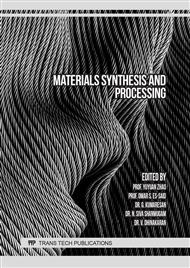[1]
P. Hidalgo-Manrique, X. Lei, R. Xu, M. Zhou, I. A. Kinloch, and R. J. Young, Copper/graphene composites: a review,, Journal of Materials Science, vol. 54, no. 19. Springer New York LLC, p.12236–12289, Oct. 15, 2019.
DOI: 10.1007/s10853-019-03703-5
Google Scholar
[2]
S. K. Tiwari, S. Sahoo, N. Wang, and A. Huczko, Graphene research and their outputs: Status and prospect,, Journal of Science: Advanced Materials and Devices, vol. 5, no. 1. Elsevier B.V., p.10–29, Mar. 01, 2020.
DOI: 10.1016/j.jsamd.2020.01.006
Google Scholar
[3]
A. E. Rashed and A. A. El-Moneim, Two steps synthesis approach of MnO2/graphene nanoplates/graphite composite electrode for supercapacitor application,, Materials Today Energy, vol. 3, p.24–31, Mar. 2017,.
DOI: 10.1016/j.mtener.2017.02.004
Google Scholar
[4]
M. Gamil, O. Tabata, K. Nakamura, A. M. R. F. El-Bab, and A. A. El-Moneim, Investigation of a new high sensitive micro-electromechanical strain gauge sensor based on graphene piezoresistivity,, in Key Engineering Materials, 2014, vol. 605, p.207–210.
DOI: 10.4028/www.scientific.net/kem.605.207
Google Scholar
[5]
P. Suvarnaphaet and S. Pechprasarn, Graphene-based materials for biosensors: A review,, Sensors (Switzerland), vol. 17, no. 10. MDPI AG, Oct. 01, 2017.
DOI: 10.3390/s17102161
Google Scholar
[6]
T. Kuilla, S. Bhadra, D. Yao, N. H. Kim, S. Bose, and J. H. Lee, Recent advances in graphene based polymer composites,, Progress in Polymer Science (Oxford), vol. 35, no. 11. Elsevier Ltd, p.1350–1375, 2010.
DOI: 10.1016/j.progpolymsci.2010.07.005
Google Scholar
[7]
A. T. Smith, A. M. LaChance, S. Zeng, B. Liu, and L. Sun, Synthesis, properties, and applications of graphene oxide/reduced graphene oxide and their nanocomposites,, Nano Materials Science, vol. 1, no. 1, p.31–47, Mar. 2019,.
DOI: 10.1016/j.nanoms.2019.02.004
Google Scholar
[8]
M. Saeed, Y. Alshammari, S. A. Majeed, and E. Al-Nasrallah, Chemical Vapour Deposition of Graphene—Synthesis, Characterisation, and Applications: A Review,, Molecules, vol. 25, no. 17. MDPI AG, Sep. 01, 2020.
DOI: 10.3390/molecules25173856
Google Scholar
[9]
R. Ikram, B. M. Jan, and W. Ahmad, Advances in synthesis of graphene derivatives using industrial wastes precursors; prospects and challenges,, Journal of Materials Research and Technology, vol. 9, no. 6. Elsevier Editora Ltda, p.15924–15951, Nov. 01, 2020.
DOI: 10.1016/j.jmrt.2020.11.043
Google Scholar
[10]
D. Kwong Hong Tsang et al., Chemically Functionalised Graphene FET Biosensor for the Label-free Sensing of Exosomes,, Scientific Reports, vol. 9, no. 1, Dec. 2019,.
DOI: 10.1038/s41598-019-50412-9
Google Scholar
[11]
A. A. Abdelsalam, S. Araby, S. H. El-Sabbagh, A. Abdelmoneim, and M. A. Hassan, Effect of carbon black loading on mechanical and rheological properties of natural rubber/styrene-butadiene rubber/nitrile butadiene rubber blends,, Journal of Thermoplastic Composite Materials, vol. 34, no. 4, p.490–507, Apr. 2021,.
DOI: 10.1177/0892705719844556
Google Scholar
[12]
F. M. Vivaldi et al., Three-Dimensional (3D) Laser-Induced Graphene: Structure, Properties, and Application to Chemical Sensing,, ACS Applied Materials and Interfaces, vol. 13, no. 26. American Chemical Society, p.30245–30260, Jul. 07, 2021.
DOI: 10.1021/acsami.1c05614
Google Scholar
[13]
L. Wang, Z. Wang, A. N. Bakhtiyari, and H. Zheng, A comparative study of laser-induced graphene by co2 infrared laser and 355 nm ultraviolet (Uv) laser,, Micromachines (Basel), vol. 11, no. 12, p.1–9, Dec. 2020,.
DOI: 10.3390/mi11121094
Google Scholar
[14]
Z. Zhang, M. Song, J. Hao, K. Wu, C. Li, and C. Hu, Visible light laser-induced graphene from phenolic resin: A new approach for directly writing graphene-based electrochemical devices on various substrates,, Carbon N Y, vol. 127, p.287–296, Feb. 2018,.
DOI: 10.1016/j.carbon.2017.11.014
Google Scholar
[15]
A. F. Carvalho et al., Laser-Induced Graphene Strain Sensors Produced by Ultraviolet Irradiation of Polyimide,, Advanced Functional Materials, vol. 28, no. 52, Dec. 2018,.
DOI: 10.1002/adfm.201805271
Google Scholar
[16]
J. Lin et al., Laser-induced porous graphene films from commercial polymers,, Nature Communications, vol. 5, 2014,.
Google Scholar
[17]
A. B. El-Basaty, E. Moustafa, A. N. Fouda, and A. A. El-Moneim, 3D hierarchical graphene/CNT with interfacial polymerized polyaniline nano-fibers,, Spectrochimica Acta - Part A: Molecular and Biomolecular Spectroscopy, vol. 226, Feb. 2020,.
DOI: 10.1016/j.saa.2019.117629
Google Scholar
[18]
T. M. Magne et al., Graphene and its derivatives: understanding the main chemical and medicinal chemistry roles for biomedical applications,, Journal of Nanostructure in Chemistry, Sep. 2021,.
Google Scholar
[19]
A. A. El-Moneim, E. Akiyama, K. M. Ismail, and K. Hashimoto, Corrosion behaviour of sputter-deposited Mg-Zr alloys in a borate buffer solution,, Corrosion Science, vol. 53, no. 9, p.2988–2993, Sep. 2011,.
DOI: 10.1016/j.corsci.2011.05.043
Google Scholar
[20]
K. M. El‐Khatib, M. O. Abou Helal, A. A. El‐Moneim, and H. Tawfik, Corrosion stability of SUS316L HVOF sprayed coatings as lightweight bipolar plate materials in PEM fuel cells,, Anti-Corrosion Methods and Materials, vol. 51, no. 2, p.136–142, Jan. 2004,.
DOI: 10.1108/00035590410523238
Google Scholar
[21]
A. Perejón, P. E. Sánchez-Jiménez, J. M. Criado, and L. A. Pérez-Maqueda, Magnesium hydride for energy storage applications: The kinetics of dehydrogenation under different working conditions,, Journal of Alloys and Compounds, vol. 681, p.571–579, Oct. 2016,.
DOI: 10.1016/j.jallcom.2016.04.191
Google Scholar
[22]
D. Jiang et al., Enhanced non-enzymatic glucose sensing based on copper nanoparticles decorated nitrogen-doped graphene,, Biosensors and Bioelectronics, vol. 54, p.273–278, Apr. 2014,.
DOI: 10.1016/j.bios.2013.11.005
Google Scholar
[23]
E. Akyilmaz, E. Yorganci, and E. Asav, Do copper ions activate tyrosinase enzyme? A biosensor model for the solution,, Bioelectrochemistry, vol. 78, no. 2, p.155–160, Jun. 2010,.
DOI: 10.1016/j.bioelechem.2009.09.007
Google Scholar
[24]
N. Verma and N. Kumar, Synthesis and Biomedical Applications of Copper Oxide Nanoparticles: An Expanding Horizon,, ACS Biomaterials Science and Engineering, vol. 5, no. 3, p.1170–1188, Mar. 2019,.
DOI: 10.1021/acsbiomaterials.8b01092
Google Scholar
[25]
S. Phetsang, P. Kidkhunthod, N. Chanlek, J. Jakmunee, P. Mungkornasawakul, and K. Ounnunkad, Copper/reduced graphene oxide film modified electrode for non-enzymatic glucose sensing application,, Scientific Reports, vol. 11, no. 1, Dec. 2021,.
DOI: 10.1038/s41598-021-88747-x
Google Scholar



